
The Exxon Valdez oil spill was a major environmental disaster that made worldwide headlines in the spring of 1989 and occurred in Alaska's Prince William Sound on March 24, 1989. The spill occurred when Exxon Valdez, an oil supertanker owned by Exxon Shipping Company, bound for Long Beach, California, struck Prince William Sound's Bligh Reef, 6 mi (9.7 km) west of Tatitlek, Alaska at 12:04 a.m. The tanker spilled approximately 10.8 million US gallons (260,000 bbl) of crude oil over the next few days.

William Bartram was an American botanist, ornithologist, natural historian and explorer. Bartram was the author of an acclaimed book, now known by the shortened title Bartram's Travels, which chronicled his explorations of the southern British colonies in North America from 1773 to 1777. Bartram has been described as "the first naturalist who penetrated the dense tropical forests of Florida".
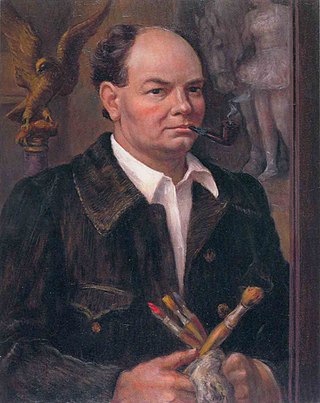
John Steuart Curry was an American painter whose career spanned the years from 1924 until his death. He was noted for his paintings depicting rural life in his home state, Kansas. Along with Thomas Hart Benton and Grant Wood, he was hailed as one of the three great painters of American Regionalism of the first half of the twentieth century. Curry's artistic production was varied, including paintings, book illustrations, prints, and posters.

Free Willy 2: The Adventure Home is a 1995 American family adventure drama film directed by Dwight Little from a screenplay by Karen Janszen, Corey Blechman and John Mattson. It is the sequel to the 1993 film Free Willy and second installment in the Free Willy film series distributed by Warner Bros. under their Warner Bros. Family Entertainment label. Jason James Richter, Jayne Atkinson, August Schellenberg, Michael Madsen and Mykelti Williamson reprise their roles from the first film. New cast members include Jon Tenney and Elizabeth Peña. Unlike the previous film where Keiko played Willy, a robotic double created by Edge Innovations was used to play the eponymous whale while the Free Willy Keiko Foundation devised a plan to bring Keiko to the Oregon Coast Aquarium where he would be rehabilitated from poor health. However, Keiko did make an uncredited appearance, reprising his role as Willy through an archival clip shown in the movie.
Robert Adams is an American photographer who has focused on the changing landscape of the American West. His work first came to prominence in the mid-1970s through his book The New West (1974) and his participation in the exhibition New Topographics: Photographs of a Man-Altered Landscape in 1975. He has received two Guggenheim Fellowships, a MacArthur Fellowship, the Deutsche Börse Photography Prize and the Hasselblad Award.

Carl-Wilhelm Reinhold de Boor is a German-American mathematician and professor emeritus at the University of Wisconsin–Madison.
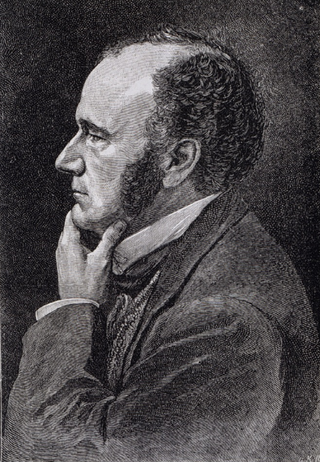
Carlile Pollock Patterson was the fourth superintendent of the United States Coast and Geodetic Survey. He was born in Bay St. Louis, Mississippi, the son of Commodore Daniel Todd Patterson. He was appointed a midshipman in the United States Navy in 1830. He studied Civil Engineering at Georgetown College, graduating in 1838, and returned to the Navy, assigned to work with the U.S. Coast Survey. He left the Navy in 1853 and captained mail steamers in the Pacific Ocean. In 1861, as a civilian, he was appointed as Hydrographic Inspector of the United States Coast Survey. In 1874, he was made Superintendent of the U.S. Coast Survey, a position he held until his death. In 1880, he was elected as a member to the American Philosophical Society.

MVNew Carissa was a freighter that ran aground and broke apart on a beach near Coos Bay, Oregon, United States, during a storm in February 1999. An attempt to tow the bow section of the ship out to sea failed when the tow line broke, and the bow was grounded again. Eventually, the bow was successfully towed out to sea and sunk. The stern section remained on the beach for over nine years until was dismantled and removed in 2008.
The United States Coast Guard is the coastal defense, search and rescue, and maritime law enforcement branch of the United States Armed Forces and is one of the country's eight uniformed services. It carries out three basic roles, which are further subdivided into eleven statutory missions. The three roles are:

USCGC Fir (WLB-213) is a Juniper-class cutter of the United States Coast Guard. USCGC Fir is under the Operational Control (OPCON) of the Commander of the Thirteenth Coast Guard District and is homeported in Astoria, Oregon. Fir's primary area of responsibility is the coastal waters, river bars and high seas of the Washingtonian and Oregonian coasts. USCGC Fir conducts heavy lift aids to navigation operations, law enforcement and other missions as directed.
William Patrick O'Connor was an American prelate of the Catholic Church. He served as the fifth bishop of the Diocese of Superior in Wisconsin (1942–1946) and the first bishop of the new Diocese of Madison in Wisconsin (1946–1967).
This timeline of the history of environmentalism is a listing of events that have shaped humanity's perspective on the environment. This timeline includes human induced disasters, environmentalists that have had a positive influence, and environmental legislation.
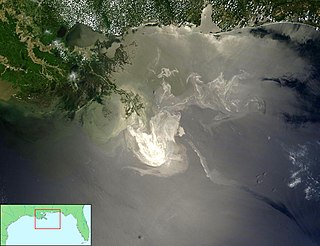
The Deepwater Horizon oil spill was an environmental disaster which began on 20 April 2010, off the coast of the United States in the Gulf of Mexico on the BP-operated Macondo Prospect, considered the largest marine oil spill in the history of the petroleum industry and estimated to be 8 to 31 percent larger in volume than the previous largest, the Ixtoc I oil spill, also in the Gulf of Mexico. Caused in the aftermath of a blowout and explosion on the Deepwater Horizon oil platform, the United States federal government estimated the total discharge at 4.9 MMbbl. After several failed efforts to contain the flow, the well was declared sealed on 19 September 2010. Reports in early 2012 indicated that the well site was still leaking. The Deepwater Horizon oil spill is regarded as one of the largest environmental disasters in world history.
Chris Craig Oynes was an American lawyer and federal government administrator.

James Angus Watson IV is a retired United States Coast Guard Rear Admiral. He currently serves as a senior vice president at the American Bureau of Shipping.
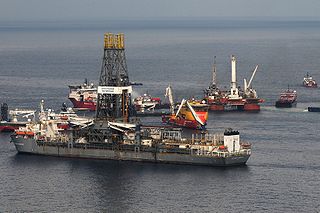
Reactions to the Deepwater Horizon oil spill from various officials and interested parties ranged from blame and outrage at the damage caused by the spill, to calls for greater accountability on the part of the U.S. government and BP, including new legislation dealing with preventative security and clean-up improvements.
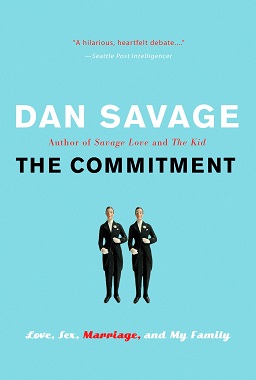
The Commitment: Love, Sex, Marriage, and My Family is a non-fiction book by Dan Savage. It was first published by Dutton in 2005. The book delves into the author's experiences with his partner Terry Miller and their adopted son as they decide whether or not to get married. Throughout the course of the book, Savage incorporates an analysis of the debate over same-sex marriage within society.

USCGC Aspen (WLB-208) is the eighth cutter in the Juniper-class 225 ft (69 m) of seagoing buoy tenders. She is under the operational control of the Commander of the Eleventh U.S. Coast Guard District and is home-ported at Yerba Buena Island in San Francisco, California. Her primary area of responsibility is the coastal waters, river bars and high seas from the California–Oregon border to San Diego, California. Aspen conducts heavy lift aids-to-navigation operations, and law enforcement, homeland security, environmental pollution response, and search and rescue as directed.
The 2004 Taylor Energy oil spill is an ongoing spill located in the Gulf of Mexico, around 11 miles (18 km) off the coast of the U.S. state of Louisiana. It is the result of the destruction of a Taylor Energy oil platform during Hurricane Ivan in 2004. It is the longest-running oil spill in U.S. history. It was first brought to public attention when contamination at the site was noticed in 2010 by those monitoring the nearby Deepwater Horizon oil spill. A report by the Associated Press in 2015 challenged the estimates of the extent of the leak originally given by the company and the U.S. Coast Guard (USCG), which were then revised to be around 1,000 times greater than initially reported.
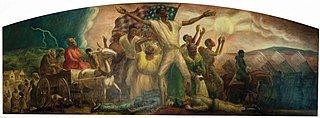
Freeing of the Slaves is an oil and tempera on canvas painting by American artist John Steuart Curry, created in 1942. It is an allegory to the Emancipation Proclamation and the abolition of slavery in the United States, in 1864. It is exhibited at the Law Library's Quarles and Brady Reading Room, in the University of Wisconsin-Madison, in Madison.














